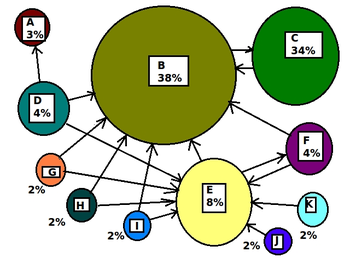Methods
Getting indexed
The leading search engines, such as Google, Bing and Yahoo!, use crawlers to find pages for their algorithmic search results. Pages that are linked from other search engine indexed pages do not need to be submitted because they are found automatically. Two major directories, the Yahoo Directory and DMOZ both require manual submission and human editorial review.[34] Google offers Google Webmaster Tools, for which an XML Sitemap feed can be created and submitted for free to ensure that all pages are found, especially pages that are not discoverable by automatically following links.[35] Yahoo! formerly operated a paid submission service that guaranteed crawling for a cost per click;[36]this was discontinued in 2009.[37]
Search engine crawlers may look at a number of different factors when crawling a site. Not every page is indexed by the search engines. Distance of pages from the root directory of a site may also be a factor in whether or not pages get crawled.[38]
Preventing crawling
Main article: Robots Exclusion Standard
To avoid undesirable content in the search indexes, webmasters can instruct spiders not to crawl certain files or directories through the standard robots.txt file in the root directory of the domain. Additionally, a page can be explicitly excluded from a search engine's database by using a meta tag specific to robots. When a search engine visits a site, the robots.txt located in the root directory is the first file crawled. The robots.txt file is then parsed, and will instruct the robot as to which pages are not to be crawled. As a search engine crawler may keep a cached copy of this file, it may on occasion crawl pages a webmaster does not wish crawled. Pages typically prevented from being crawled include login specific pages such as shopping carts and user-specific content such as search results from internal searches. In March 2007, Google warned webmasters that they should prevent indexing of internal search results because those pages are considered search spam.[39]
Increasing prominence
A variety of methods can increase the prominence of a webpage within the search results. Cross linking between pages of the same website to provide more links to most important pages may improve its visibility.[40] Writing content that includes frequently searched keyword phrase, so as to be relevant to a wide variety of search queries will tend to increase traffic.[40] Updating content so as to keep search engines crawling back frequently can give additional weight to a site. Adding relevant keywords to a web page's meta data, including the title tag and meta description, will tend to improve the relevancy of a site's search listings, thus increasing traffic. URL normalization of web pages accessible via multiple urls, using the canonical link element[41] or via 301 redirects can help make sure links to different versions of the url all count towards the page's link popularity score.

You have written wonderful article. Greetings and thank you
ReplyDeleteTop SEO Company in Punjab
SEO services Chandigarh